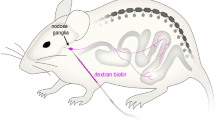Studies using immunohistochemical markers – synaptophysin (SP), protein gene product 9.5 (PGP 9.5), and tyrosine hydroxylase (TH) – addressed the innervation of the pancreas and the myenteric nerve plexus of the duodenum (duodenum) in neonatal rats (n = 4) and demonstrated a tight link between the nerve plexuses in these organs. Some elements of the myenteric plexus penetrate the pancreas from the walls of the duodenum. Morphological and biochemical similarity was demonstrated between microganglia in the myenteric plexus of the duodenum and pancreas. Most differentiated neurons and bundles of axons in both plexuses were part of the parasympathetic compartment of the autonomic nervous system. There were no catecholaminergic neurons in the pancreas, and bundles of sympathetic fibers entering the organ from outside were few in number and were involved mainly in innervating blood vessels. This is the first report of the use of immunohistochemical reactions for PGP 9.5, SP, and TH to detect two types of nerve fibers in ganglia in the pancreas whose varicose terminals form cholinergic and catecholaminergic synapses around nerve cell bodies.
Similar content being viewed by others
References
I. I. Dedov, G. A. Mel’nichenko, and V. V. Fadeev, Endocrinology, Meditsina, Moscow (2000).
E. A. Kolos, I. P. Grigor’ev, and D. E. Korzhevskii, “Synaptophysin – a marker for synaptic contacts,” Morfologiya, 147, No. 1, 78–82 (2015).
D. E. Korzhevskii, O. V. Kirik, E. S. Petrova, et al., Theoretical Bases and Practical Application of Immunohistochemical Methods (guidelines), SpetsLit, St. Petersburg (2014).
Yu. S. Krivova, V. M. Barabanov, E. I. Fokin, and S. V. Savel’ev, “Immunohistochemicalstudies of the endocrine part and nervous apparatus of the pancreas in children with type 1 diabetes mellitus,” Klin. Eksperim. Morfol., No. 2, 28–31 (2012).
E. I. Chumasov, N. A. Maistrenko, E. S. Petrova, et al., “Morphological studies of the pancreas in chronic pancreatitis using immunohistochemical markers,” Med. Akadem. Zh., 13, No. 2, 71–77 (2013).
E. I. Chumasov, E. S. Petrova, and D. E. Korzhevskii, “Features of the interaction of the neural apparatus, islets of Langerhans, and blood vessels in the pancreas in rats,” Med. Akadem. Zh., 13, No. 3, 38–44 (2015).
P. Borden, J. Houtz, S. D. Leach, and R. Kuruvilla, “Sympathetic innervation during development is necessary for pancreatic islet architecture and functional maturation,” Cell Rep., 4, No. 2, 287–301 (2013).
P. In’t Veld and S. Smeets, “Microscopic anatomy of the human islet of Langerhans,” in: Islets of Langerhans, M. S. Islam (ed.), Springer Science+Business Media, Dordrecht (2015), pp. 19–37.
T. Fujita, “Histological studies on neuro-insular complex in the pancreas of some mammals,” Z. Zellforsch., 50, 94–109 (1959).
A. L. Kirchgessner and M. D. Gershon, “Innervation of the pancreas by neurons in the gut,” J. Neurosci., 10, No. 5, 1626–1642 (1990).
A. L. Kirchgessner and J. E. Pintar, “Guinea pig pancreatic ganglia: projections, transmitter content, and the type-specific localization of monoamine oxidase,” J. Comp. Neurol., 305, No. 4, 613–631 (1991).
S. B. Koevary, R. C. McEvoy, and E. C. Azmitia, “Specific uptake of tritiated serotonin in the adult rat pancreas: evidence for the presence of serotonergic fibers,” Am. J. Anat., 159, No. 3, 361–368 (1980).
M.-T. Liu and A. L. Kirchgessner, “Guinea pig pancreatic neurons: morphology, neurochemistry, electrical properties, and response to 5-HT,” Am. J. Physiol., 273, 1273–1289 (1997).
P. G. Luiten, G. J. ter Horst, S. J. Koopmans, et al., “Preganglionic innervation of the pancreas islet cells in the rat,” J. Auton. Nerv. Syst., 10, No. 1, 27–42 (1984).
S. Persson-Sjögren, A. Zashihin, S. Forsgren, “Nerve cells associated with the endocrine pancreas in young mice: an ultrastructural analysis of the neuroinsular complex type I,” Histochem. J., 33, No. 6, 373–378 (2001).
P. M. Pour and M. Saruc, “The pattern of neural elements in the islets of normal and diseased pancreas and in isolated islets,” J. Pancreas, 12, No. 4, 395–405 (2011).
R. Rodriguez-Diaz, M. H. Abdulreda, A. L. Formoso, et al., “Innervation patterns of autonomic axons in the human endocrine pancreas,” Cell Metab., 14, No. 1, 45–54 (2011).
B. Salvioli, M. Bovara, G. Barbara, et al., “Neurology and neuropathology of the pancreatic innervation,” J. Pancreas, 3, No. 2, 26–33 (2002).
Author information
Authors and Affiliations
Corresponding author
Additional information
Translated from Morfologiya, Vol. 150, No. 5, pp. 24–30, September–October, 2016.
Rights and permissions
About this article
Cite this article
Chumasov, E.I., Petrova, E.S. & Korzhevskii, D.E. Structural Organization and Interaction of Intrapancreatic Ganglia with the Myenteric Nerve Plexus of the Duodenum at the Early Stages of Postnatal Ontogeny in Rats. Neurosci Behav Physi 47, 857–862 (2017). https://doi.org/10.1007/s11055-017-0482-3
Received:
Published:
Issue Date:
DOI: https://doi.org/10.1007/s11055-017-0482-3




